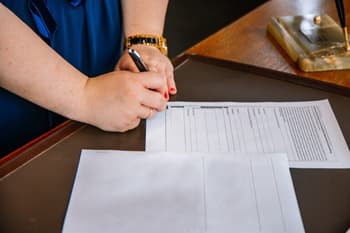In Short
-
Registering a trade mark gives your business exclusive legal rights over names, logos, slogans and other distinctive branding elements, helping stop copycats and strengthen your brand.
-
The registration process can take around 7 to 8 months and involves choosing the correct classes, checking for existing marks, and passing an opposition period.
-
Once registered, you can use ® to signal ownership, monitor and defend against infringements, and even license the mark to others.
Tips for Businesses
Before applying, search thoroughly to check your mark’s availability, and choose the right classes to avoid later issues. Use the ® symbol on materials as soon as registration is complete, keep an eye out for possible infringements and be prepared to act swiftly to protect your brand’s value and reputation.
As your business becomes profitable, your brand’s value grows. After investing your finances and creativity into building a recognised brand, you’re now starting to stand apart in the market. However, you do not want competitors copying your brand’s distinguishing features. Registering a trade mark can give legal protection to the components that make up your brand (names, logos, taglines, colours, sounds and even unique packaging shapes).
This article explains why registering a trade mark is important, how you can best use one and how to complete the registration process.
The Advantages of Registering a Trade Mark
The advantages of registering a trade mark grow as you use it. At first, you will receive legal rights to the trade mark. However, as your business grows, your trade mark’s value increases the more you use it.
It is important to understand that a registered trade mark offers different protection and serves a different purpose to a registered business name. A business name does not give its owner the exclusive right to use the name; in the absence of a trade mark registration, competitors can still use a similar name. Conversely, a trade mark owner has the right to monetise their brand through licensing and prevent competitors from using a similar name or mark.
Use Your Trade Mark Appropriately
- Use the ® Symbol Correctly: Use the ® symbol on your website, social media pages and on products to let others know that your trade mark is officially registered in Australia. It is crucial to only use this symbol on registered trade marks. Using it on an unregistered trade mark is a legal offence under the Trade Marks Act 1995, which can lead to significant fines. If your trade mark is unregistered, instead use the ™ symbol to signify to others that you are using it as your trade mark.
- Consistency is Key: For maximum protection, you must continue to use your trade mark in connection with the classes of goods and services you have registered it against. If you neglect to use your trade mark for a 3-year period, it may be vulnerable to removal from the register by a third party.
- Monitor and Defend: You will need to be on the lookout for potential infringers. With the rise of AI-powered tools, it is easier than ever for competitors to create deceptively similar branding. Put an end to infringement quickly by sending a Cease and Desist letter. The longer a competitor uses a similar mark, the more difficult it becomes to enforce your rights.
Commercialise Your Trade Mark Through Licensing
As your business grows, your reputation will make your trade mark more valuable. A trade mark attached to a business with a good reputation will attract the attention of other business owners who may also want to share an association with your business.
You can give other business owners permission to use your trade mark in certain circumstances through a licence. This allows you to retain ownership and maintain control over the brand, but expand your market. Licences to use trade marks can come in the form of business models like franchise, reseller or agency relationships.


This guide explains the essentials of trade marks and the steps required to register a trade mark.
When to Start Registering a Trade Mark
In Australia, trade mark registration is, in principle, obtained on a first-to-file basis. This means the earlier you file for trade mark registration, the safer. Pragmatically, however, this may not always be an option.
For smaller companies that are still building their reputation and revenue, it is worth weighing up the cost of trade mark registration against projected revenue profit. It is very common for new business owners to test the waters before committing to their brand and starting the registration process. You can, while the business is still starting out, take other measures to prevent infringers of your intended trade mark until you do register it. Many business owners use ™ next to their trade marks to indicate their intention to use the symbol as a trade mark. Though it is not a registered right, the ™ symbol acts as a deterrent.

The Application Process
First, research your industry to ensure you are not infringing on anyone else’s intellectual property, and to make sure your trade mark is different and unique enough to be registered. IP Australia now offers an AI-powered tool called “TM Checker” to assist with this initial search.
IP Australia may reject your application for several reasons. Therefore, when you are choosing your trade mark, you should ensure that:
- it does not contain a sign that is not able to be registered under the Commonwealth (for example, the Australian flag);
- it does not contain anything scandalous or contrary to law;
- it is unlikely to deceive or cause confusion;
- the trade mark is capable of distinguishing your business; and
- the trade mark is not identical or deceptively similar to a pending or registered trade mark.
However, it is not necessarily a problem if your trade mark is similar to one in another industry. For example, trade marks for Dove chocolates can peacefully coexist alongside those for Dove beauty products. The two trade marks are unlikely to confuse anyone, since consumers are unlikely to think that the same trader produces both chocolates and beauty products.
Once IP Australia approves the application, the details are published for an advertisement period of two months. Other people can oppose your trade mark application within this period on certain grounds. For example, on the grounds that they already have a registered trade mark very similar to yours. If no one files an opposition, or they are unsuccessful, you will then be granted a registered trade mark, renewable every 10 years.
Key Takeaways
Registering a trade mark allows you to safeguard your brand in an increasingly competitive digital market. As your business grows, your trade mark will also increase in value, distinguishing your business in the market and providing a valuable commercial asset.
If you need help with the trade mark application process, our experienced trade mark lawyers can assist as part of our LegalVision membership. For a low monthly fee, you will have unlimited access to lawyers to answer your questions and draft and review your documents. Call us today on 1300 544 755 or visit our membership page.
Frequently Asked Questions
A trade mark is a type of intellectual property that allows you to distinguish your brand from others. It acts as a badge of origin in the marketplace, allowing consumers to easily identify your goods and services. Registering your trade mark provides broader legal protection than that afforded to an unregistered mark.
Registering a trade mark provides you with exclusive rights to use your mark within the classes of goods and services you select. It also provides you with the right to license your mark and claim infringement against copycats.
Trade mark registration lasts for 10 years from the filing date and can be renewed indefinitely for successive 10-year periods, provided you continue to use the mark in commerce and pay renewal fees.
We appreciate your feedback – your submission has been successfully received.











